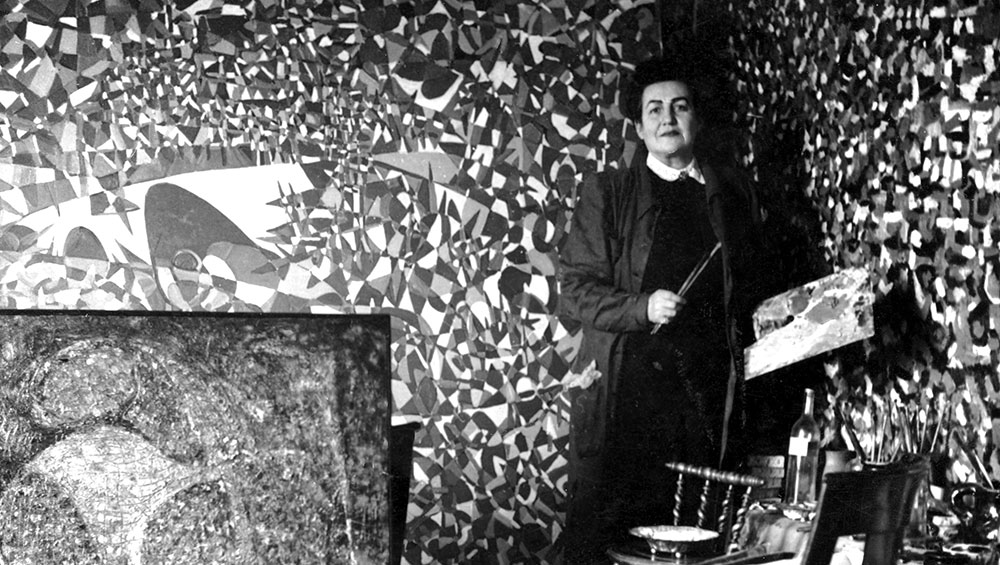
Fahrelnissa Zeid in her studio. © Raad Zeid Al-Hussein.
Guggenheim Bilbao
22 October 2021 – 27 February 2022
by VERONICA SIMPSON
“This painting is so good, you’d never know it was done by a woman.” So said the painter Hans Hofmann in 1937, of an abstract work by Lee Krasner. That comment was clearly a product of its times, but, until the late 1980s, those attitudes prevailed in a scene dominated by white, male artists, museum directors, critics and art historians – with the occasional woman breaking through as the rare exception. That is one of the reasons we need this show: a mammoth effort to shine a light on some of the female talents that somehow thrived between the late-19th century and the 1980s.
-installation-shot.jpg)
Lee Krasner. Untitled, 1949. Installation view. Photo: Veronica Simpson.
There are some who might take issue with this show from the off, arguing, quite rightly, that to label any artist by their gender is reductive – after all, said the curator Christine Macel, at the press opening: “I don’t call myself a woman curator.” However, Macel, who is chief curator at the Centre Pompidou, where this exhibition was first shown, went on to explain: “For me, it was a statement to make these women visible, because one theme of this exhibition is invisibilisation.” That clunky word – if such a word exists - is the driver for some of the key narratives within this show. It obviously relates to the systematic sexism of the institutions, commercial galleries, art historians and critics who, on the basis of gender, failed to include or promote the work of these artists. It also justifies the show’s exploration of areas that were not previously seen as part of the abstract art canon – dance, theatre, photography, textiles, fashion and film - because these arenas were much more open to women. In this way, the show also reveals the connections between these disciplines, highlighting the porousness of the cultural landscape, as new ideas percolate from one arena to the other, fuelled by philosophy, literature, conversation, interaction and performance. What this reveals, says Lekha Hileman Waitoller, curator of the Guggenheim Museum Bilbao and the show’s organiser, is that these women “were the co-creators of modernism”.
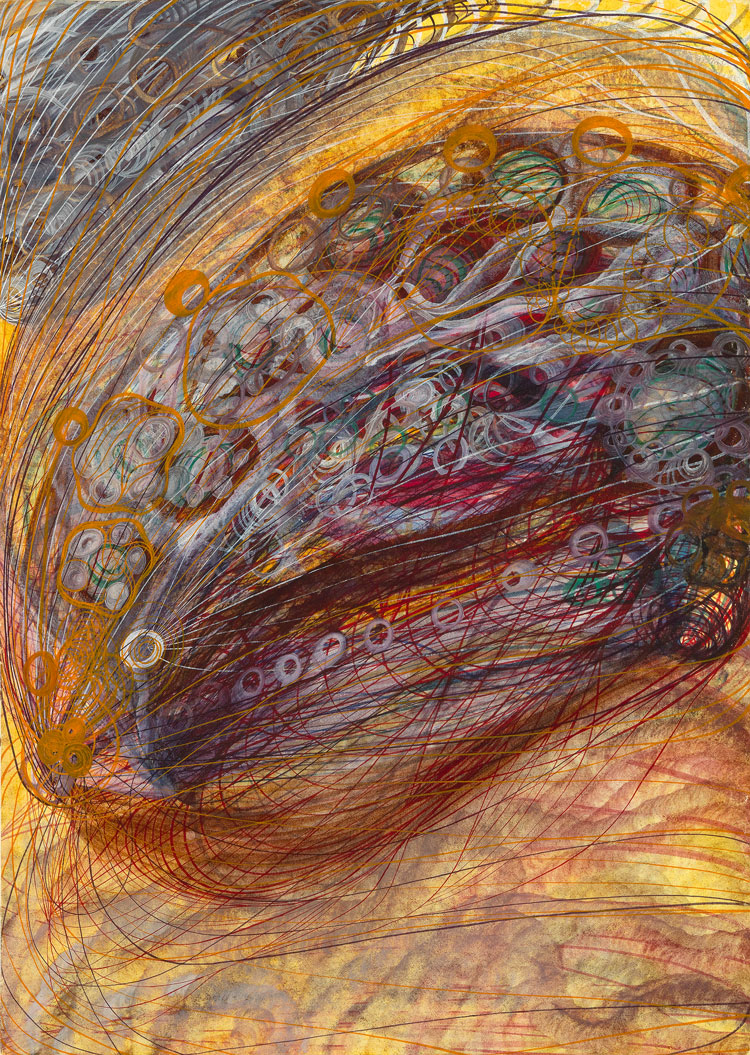
Georgiana Houghton. Album of Spirit Art, 1866-84. Album containing a series of watercolours by Georgina Houghton and other artists, 49 x 42 x 3.5 cm. The College of Psychic Studies, London. Image courtesy of The College of Psychic Studies, London.
The curators have also expanded their gaze beyond the traditional central or western European and US focus to include Latin America, the Middle East and Asia. That expansiveness of gaze, discipline and region pretty much justifies why there are more than 100 artists and nearly 400 works dispersed around the Guggenheim. This generosity and scale mean there are some wonderful discoveries to be made. The first of these for me is Georgiana Houghton (1814-84), famous in her time as a spiritualist artist, whose richly hued gouache and watercolour works became increasingly abstract in the 1860s and 70s. Those shown here pulse with swirling white lines, which she said were “representations of the currents of God’s love”, according to Macel. Houghton, whose work has been rediscovered and appreciated of late, was one of many artists whose involvement in various theosophical societies inspired remarkable works. Also present in this section are Alice Essington Nelson (1846-1921), Olga Fröbe-Kapteyn (1881-1962) and Hilma af Klint (1862-1944), whose spare, geometric visions were decades ahead of her time.
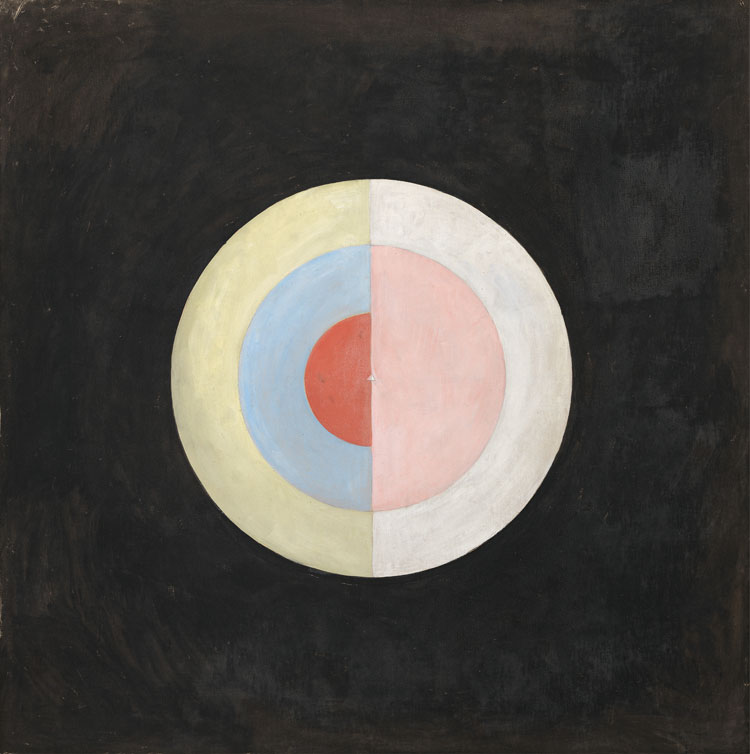
Hilma Af Klint. The Swan, No. 16, Group IX/SUW, 1915. Oil on canvas, 154.5 x 151 cm. Courtesy of The Hilma af Klint Foundation. © Hilma Af Kint, VEGAP, Bilbao, 2021. Photo: Moderna Museet, Stockholm.
Incorporating dance makes absolute sense – women have often been in the vanguard of dance movements, stripping away the pomp and fripperies of previous eras to create something more lean, dynamic, essential and pure in its expression. In the first part of the 19th century, their explorations of form and geometry were a great inspiration for other artists. Loïe Fuller (1862-1928) is a case in point: her famous Serpentine Dance film is shown here, in all its pastel-tinted splendour; though it’s not Fuller herself but an inspired imitator sweeping those folds of silk vigorously around her form, creating mesmerising geometric patterns as she moves. Alongside it there is a glowing review reprinted in full from a Paris journal, describing Fuller’s impact on the artists of the day thus: “No one person ever so inspired painters with ideas of drapery and ideas of movement. She ranks with the great creators and with the great geniuses of the ages.” Also represented here – though sadly not captured on film but in portrait and full figure photographs - are Giannina Censi (1913-1995), Gret Palucca (1902-1993) and the choreographer and painter Valentine de Saint-Point (1875-1953).
.jpg)
Giannina Censi, Aerodances, 1931. Installation view. Photo: Veronica Simpson.
There is a strong section on Russian avant-garde artists, thanks to Russia being one of few countries (along with the UK) that accepted women into fine art academies before 1910. Here, we see the famous Natalia Goncharova (1881-1962) and Liubov Popova (1889-1924), and a particularly striking painting, Constructivist Still Life (1920-21), by Alexandra Exter (1882-1949). There is also Aelita, the 1924 science fiction film directed by Yakov Protazanov, whose set and costumes Exter created, conjuring extraordinary outfits in Perspex and aluminium to compensate for the dreary black and white tones that this early film dictated.
-installation-shot.jpg)
Alexandra Exter. Constructivist Still Life, 1920-21. Oil on canvas. Installation view. Photo: Veronica Simpson.
Sonia Delaunay-Terk (1885-1979) appears shortly afterwards, in this roughly chronological display, sharing an expanded “moment” near to Sophie Taeuber-Arp (1889-1943). In the show’s narrative, both are women who achieved some recognition as artists in their time, but they also serve to demonstrate that, as brilliant as they were in their chosen art forms, they had to be resourceful and multifaceted to survive. Tauber-Arp created furniture and fabulous interiors as well as fashion and Delaunay-Terk explored costume, textile and fashion design, even opening a fashion store in Madrid during her refugee years during the first world war.
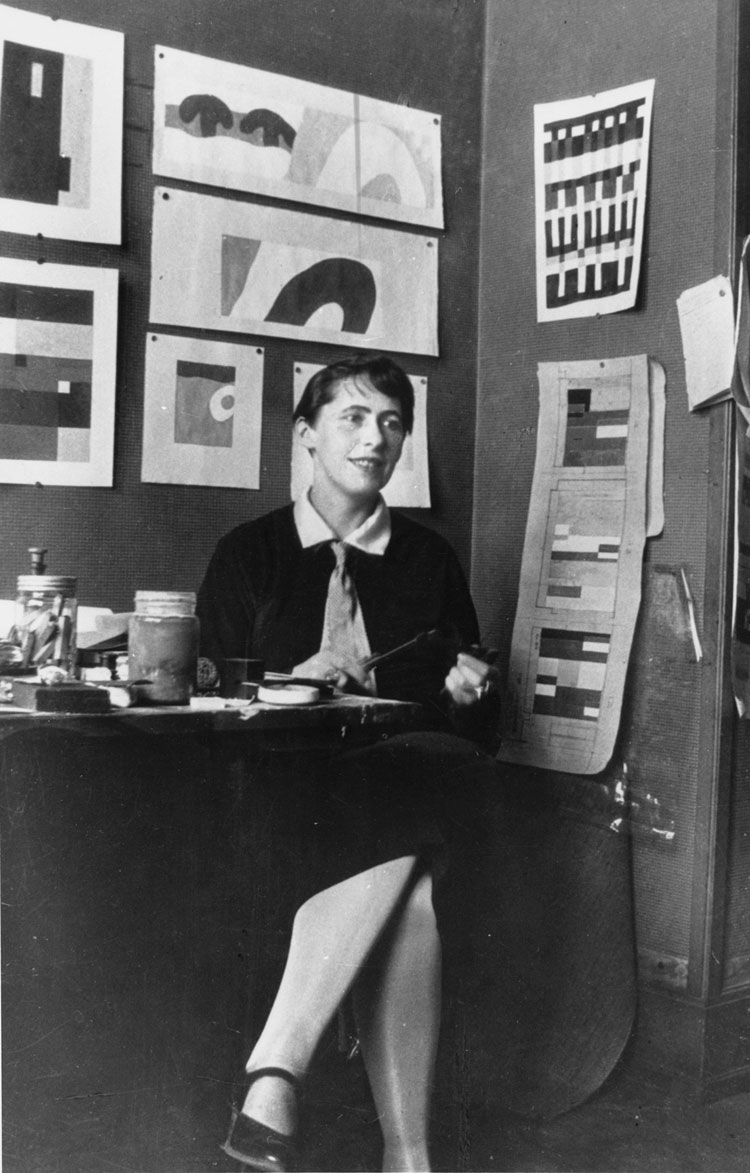
Sophie Taeuber-Arp in her studio-office at l’Aubette, 1927. Collection Fondation Arp, Clamart.
Bauhaus women are also given their own section, in a nod to the school’s famous claim to welcome both genders: in reality, it usually parcelled women off to the textile workshops. And there they flourished. Given Anni Albers’ greater fame within the group, fostered by several recent retrospectives, it is nice here that others take centre stage. Gertrud Arndt (1903-2000) is represented with a beautiful, eye-poppingly chromatic rug that Bauhaus founder Walter Gropius liked so much he appropriated it for his office; as Macel points out, he may have downgraded the importance of women’s contribution as artists, but he certainly appreciated their selling power as sales of their textiles helped to fund the school. Nearby, a delicate Woven Wall Hanging (1923-4) by Benita Koch-Otte (1892-1976) also dazzles.
Photography follows, revealing some treasures - no doubt thanks to the co-curatorial involvement of Karolina Lewandowska, curator of photography and director of the Museum of Warsaw. The works of Florence Henri (1893-1982) and Elsa Thiemann (1910-81) shine bright. The latter was a Bauhaus student who progressed from drawing to photography, creating some arresting imagery from everyday objects, as did the French artist Germaine Dulac (1882-1942), who is perhaps better known for having made the first surrealist film, The Seashell and the Clergyman (1927). A foray into “microphotographie decorative” also reveals fresh talent and perspectives from France’s Laure Albin-Guillot (1879-1962) and Germany’s Lotte Jacobi (1896-1990).
-installation-shot.jpg)
Marlow Moss. White, Black, Red and Grey, 1932. Installation view. Photo: Veronica Simpson.
Throughout the show there is a nice balance between lesser-known talents with big names. Georgia O’Keeffe (1887-1986) is here, of course, as is Barbara Hepworth (1903-75), whose sculptures, along with a biographical film, are complemented by a sequence of abstract works by Marlow Moss (1889-1958), of whom I’d never heard. Born Marjorie Jewell Moss, she rejected her affluent, conservative, north London Jewish upbringing, shaved off her hair and changed her dress and her name so that her art could flourish. She studied at the Slade, then spent time in Penzance before moving to Paris to enrol at Fernand Léger’s Académie Moderne. Here, she discovered Piet Mondrian, with whom she began a long correspondence. His influence is clearly visible in the work here, but she also influenced him - she began to use a double line in her geometric compositions, to make them more dynamic, “an innovation that Mondrian was to adopt two years later,” according to the handsome show catalogue.
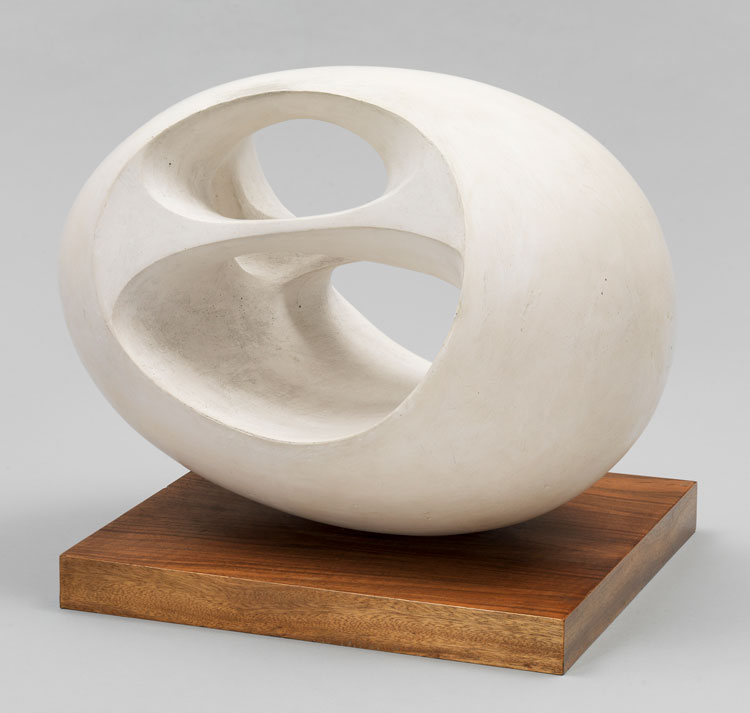
Barbara Hepworth. Oval Sculpture (N°2), 1943, cast 1956. Plaster on wooden base, 29.3 x 40 x 25.5 cm. Tate, presented by the artist, 1967. © Bowness. © Tate.
Where women may have often been stifled as artists, a few pioneers thrived as collectors, gallerists and curators. Two were especially influential in the history of abstract art as well as bringing female artists into the fold: Peggy Guggenheim and Hilla Rebay. Born in Strasbourg, Rebay (1890-1967) studied painting and established herself as a portraitist, moving to the US in 1927. Here, a commission to paint Solomon R Guggenheim’s wife, Irene, proved pivotal. Discovering a shared enthusiasm for abstract (or non-objective) art, the Guggenheims and Rebay travelled throughout Europe to build a collection, with Rebay becoming curatorial director for their Museum of Non-Objective Painting in 1939, then selecting Frank Lloyd Wright to build the New York Guggenheim. Peggy Guggenheim’s contribution is better known: never calling herself a feminist, she was nonetheless remarkably even-handed in her selection of artists, regardless of gender. Her famous museum space dedicated to abstract and surrealist art, Art of This Century (which opened in 1942), featured nearly 40% women. She also organised two essential exhibitions of female artists, her 1943 Exhibition by 31 Women and The Women in 1945.
-(1956-99).jpg)
Atsuko Tanaka. Denkifuku (Electric Dress, 1956/99. Installation view. Photo: Veronica Simpson.
Janet Sobel (1893-1968) was one of Guggenheim’s “finds”, though the more widely celebrated Krasner (1908-84) refused to be part of her women–only shows. There are also some glorious works here by other US artists of the day, Joan Mitchell (1925-92) and Helen Frankenthaler (1928-2011), who pioneered what came to be known as “colour field abstraction”, through the pouring of paint thinned with turpentine directly on to the canvas, to capture the quicksilver, elemental aspects of life and nature. Her Cool Summer (1962) links nicely to the dynamic acrylic paintings of the Korean artist Wook-Kyung Choi (1940-85) in the subsequent room, which marks the beginning of the show’s geographic expansion. Nearby, the extraordinary Denkifuku (Electric Dress, 1956/99), by the Japanese artist Atsuko Tanaka (1932-2005), pulses periodically with light, while pulsating life is represented by two geometric paintings, resembling microscopic closeups of sperm or tadpoles - Untitled (1959). Another discovery (for me) is the work of the Portuguese artist Maria Helena Vieira da Silva (1908-92), with a triple whammy of pale grey, textured paintings that speak of an otherworldly landscape, as much interior as exterior experience.
From here, we move into more sculptural, experimental territory, beginning with a mobile wooden sculpture by the Hungarian artist Marta Pan (1923-2008), looking for all the world like a jawbone. Le Teck (1956) is a teak structure designed to be danced with, as the accompanying film demonstrates. A whirling male and female duo emote, express and caress each other around the sculpture with the woman ultimately ending up trapped as her companion closes the “jaw” over her waist. The far end of this gallery hosts a sequence of exquisite metal wire pieces, two by Claire Falkenstein (1908-97) and two by Ruth Asawa (1926-2013).
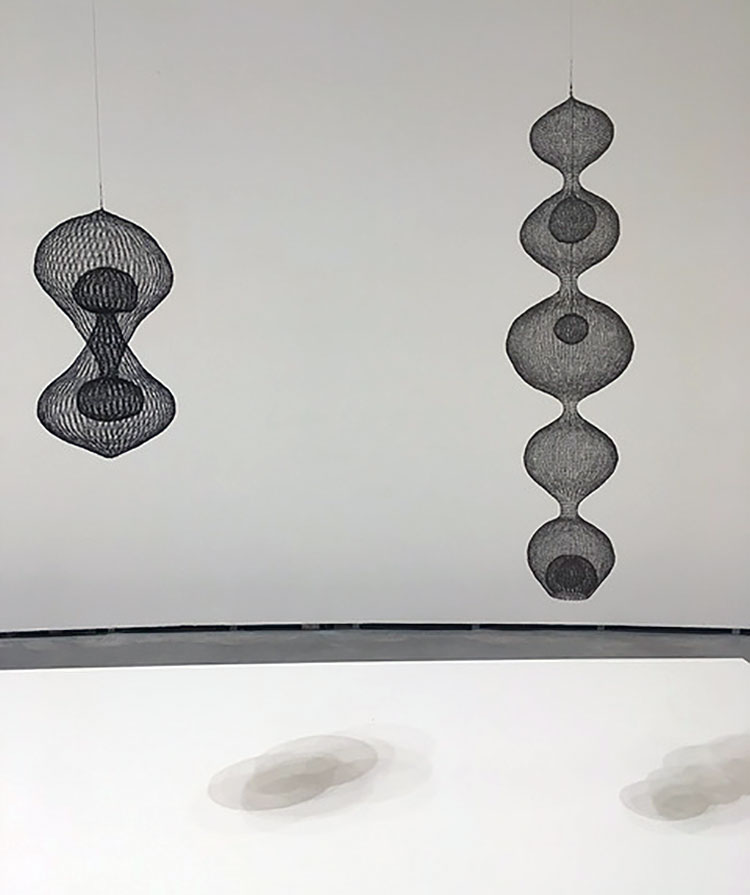
Ruth Asawa. Installation view. Photo: Veronica Simpson.
Then we are back into painting, but reaching out beyond Europe and the US with two works by Carmen Herrera (b1915, Havana, Cuba), paintings and sculpture inspired by Arabic script from the Lebanese artist Saloua Raouda Choucair (1916-2017) and a wonderful huge oil painting by the Turkish artist Fahrelnissa Zeid (1901-91), The Arena of the Sun (1954), rippling with primary colours and complex patterns.
There are subsections devoted to explorations of the line (Arpita Singh, Judit Reigl, Agnes Martin) and also to the op-art pioneers (including Bridget Riley) and to textile art, or “fibre art”, including Spain’s underappreciated Aurèlia Muñoz (1926-2011) and the US’s Sheila Hicks (b1934).
With more than 100 artists and so much work there is far too much to list here, though I must mention an appreciation of the last section, where a wall of women – photos of each of these artists - is assembled so that we know who they are and might even come to recognise them, if not in the way that we instantly recognise portraits of their famous male contemporaries. It sits opposite a little room mostly dedicated to the work of Etel Adnan (b1925, Beirut) – who thankfully now, in her later years, is getting the recognition she deserves - with a couple of paintings by Helen Khal (1923-2009).
If the point of this show is to underline how much female artists contributed over this period, against all the odds, it achieves its aims. Hopefully, it will also launch multitudes of art lovers along their own avenues of enquiry into the lesser-known talents displayed within this dazzling constellation, the majority of whom burned all-too briefly. And if the overwhelming impression is of richness, resilience and resourcefulness, one is also left haunted by the thought of how much brighter and longer they might have burned under today’s more equitable conditions.